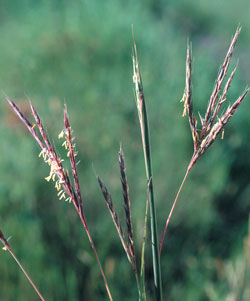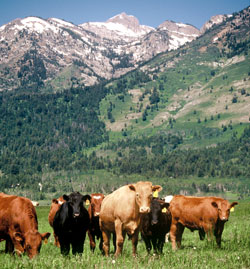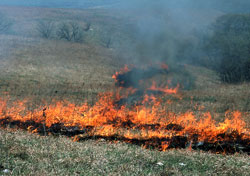Range plants – the grasses, forbs and shrubs that predominate on arid landscapes – have adapted to the seasonality of rainfall and temperatures. On warmer rangelands that typically receive summer rains – the Great Plains and the Southwest – the warm-season native plants mostly grow in July and August. In the Great Basin and along the Rocky Mountain Front where most of the moisture occurs before July 1, cool-season plants predominate, and 98 percent of the forage production occurs by the end of June.

By being aware of what range plants grow on your ranch, and what they need to thrive, you can plan to take advantage of each species’ niche.
In Texas’ slice of the High Plains region, water scarcity drives decision-making for farmers and ranchers. Researchers at Texas Tech are experimenting with warm-season grasses and innovative rotations of cattle and cotton to stretch their aquifer-dependent water supply. Vivien Allen, a Texas Tech researcher who has won two SARE grants, is testing Bermuda grasses, Dahl bluestem and Tifton 85, which are water-efficient and saline-tolerant. “It’s hot, it’s dry – that’s what’s adapted out here,” Allen says.
Nebraska hosts both warm- and cool-season grasses, so Overton producer Teri Edeal used SARE funds to experiment with both types by dividing her quarter-section pivot pasture into eight paddocks. Her first seeding mixture was mostly cool-season grasses, causing a forage shortage for Edeal when those grasses quit growing in July. So she reseeded with Bonanza, a new variety of big bluestem.
“Bonanza is a warm-season grass so it should fill the gap in July and August,” Edeal says.
Regardless of the season of most growth, all range plants need to be grazed and experience periodic rest from grazing during the growing season to remain healthy and productive.
Grasses and forbs are especially vulnerable to harmful grazing during the boot stage, when the seed head is rapidly shooting up from the base of the plant to the pinnacle. Almost all of the plant’s energy goes to the stem and seed head. If leaves are grazed during this period, the plant can not photosynthesize enough energy so it draws from the roots, potentially weakening them.
Similarly, repeated grazing during the growing season is hardest on grasses because the plant keeps using all of its energy to grow new leaves, drawing energy from the roots and endangering their health. Various species need different lengths of leaves to photosynthesize enough energy to balance leaf and root growth, but a good rule of thumb is that leaves need to be at least 2 inches long before they provide enough photosynthesis for healthy roots.
The take-home message for sustainable grazing is to consider such factors as plant physiology, climate, season and your goals and develop a plan for grazing each plant in a way that sustains both the plant and the herd. For example, consider a plan that specifies grazing a given pasture in June one year, then during a different month next year.
“Instead of designing a grazing plan around the time a plant is grazed, you should design it around the amount of rest,” says Agee Smith, the Nevada rancher.

Researchers continue to test the rest and grazing requirements of various species so landowners can apply optimum grazing practices to their local preferred plants, but land managers are behind the eight ball. With a lack of understanding about plants’ fundamental needs, historic grazing practices often encouraged less desirable species and even noxious weeds. Now, ranchers are playing catch-up to not only graze optimally, but also remediate past grazing practices.
“Vegetation change is slow,” says Tim DelCurto, a researcher at Oregon State University’s Eastern Oregon Agricultural Research Center. “You don’t see the impact [of improper grazing] at first. We’re just starting to understand the systems.”
DelCurto and Pat Momont, Extension Beef Specialist at University of Idaho, received a SARE grant to study better ways to manage beef cattle grazing in mountain riparian ecosystems.
In ongoing experiments, researchers continue to try to describe range ecosystems and how grazing affects those systems. Since 1916, many scientists subscribed to the theory that grazing practices are the most important influence on range plant production and species composition. Frederic Clements, whose continuing influence is evident in most range management textbooks, advanced this model; however, he developed his idea on pasturelands with consistent, predictable rainfall. Since the 1990s, others have developed the State-and-Transition theory for areas with less predictable rainfall that recognizes drought’s huge influence on plants – much more than grazing. This theory suggests that ecosystems typically retain a relatively stable mix of plant species unless a drastic change forces a new set of species. On western rangelands, that forceful change often comes in the form of drought.
Now scientists recognize that ecosystems fall on a continuum between these two theories, depending on the frequency and severity of area droughts. Moreover, they see the significant impact of other management tools besides cattle grazing – logging, tillage, multi-species grazing, noxious weed control and burning, among others.
Within Kansas’ tallgrass prairie, area ranchers traditionally burn their prairie pastures each spring, stimulating plant growth and increasing palatability before summer grazing. Jane Koger of Matfield Green, Kan., has stopped burning her entire acreage each spring to better manage her cattle and preserve the ecosystem, along with some of its unique birds.
Koger, who raises a herd of 85 cow-calf pairs on 4,000 acres of tallgrass prairie, developed a patch burning system to maintain a shifting mosaic of burned and unburned, grazed and ungrazed areas.
Kroger and an advisory team of another rancher, a youth partner and representatives from the U.S. Fish & Wildlife Service, Natural Resources Conservation Service and The Nature Conservancy, decided to improve wildlife habitat and revitalize Homestead Ranch pastures by burning a third of each of her 960-acre pastures each spring. They started by surveying 80 square miles to assess the impact of annual burns. They found 90 percent of the available grassland had been burned, reducing migratory bird nesting and feeding habitat just when the birds need it most.
In 2004, the team began patch-burning, following a burn plan developed with NRCS. The plan used an aerial mapping system to segment Koger’s acreage using natural borders like roads and low-lying areas where water accumulates. The team’s work was supported by a SARE grant.

The patch fires mimic historic patterns in nature and control the movement of the livestock, which migrate to the burned areas a few days after fire. The new growth is more palatable than grasses that typically grow 3 feet high, said Koger, who saw her herd spend 80 percent of their time in a just-burned patch. Moreover, patch burning leaves two years of old-growth grass, creating more fuel for a hotter burn in the next cycle to destroy trees and other invasive, woody species.
“Patch-burning naturally guides grazing,” Koger says, referring to the tendency of livestock to seek fresh vegetation, then gravitate to the unburned sectors as the amount of forage in the burned sector declines. “It’s what the Native Americans did to attract the buffalo. We’re just following the historical burning to attract the animals.”
The patch-burning is good for the birds, too. Results of bird sightings and bird calls reveal an increase in bobwhite, eastern meadowlark, grasshopper sparrow and greater prairie chickens. They also sighted the Henslow’s sparrow, which Koger called “a unique harbinger of prairie integrity, requiring unburned, lightly grazed native prairie.”
To learn more about plant needs and manage grasses, forbs, shrubs or trees, visit:
- Society for Range Management, www.rangelands.org/srm.shtml
- Natural Resources Conservation Service PLANTS database, https://plants.usda.gov/
- NRCS Plant Materials Program, https://plant-materials.nrcs.usda.gov/
